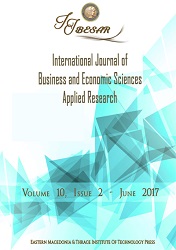The British Stock Market under the Structure of Market Capitalization Value: New Evidence on its Predictive Content
The British Stock Market under the Structure of Market Capitalization Value: New Evidence on its Predictive Content
Author(s): Catherine GeorgiouSubject(s): National Economy, Policy, planning, forecast and speculation, Economic development, Financial Markets
Published by: Τεχνολογικό Εκπαιδευτικό Ίδρυμα Ανατολικής Μακεδονίας και Θράκης
Keywords: Return predictability; dividend growth; earnings growth; size portfolios; FTSE 100;
Summary/Abstract: Purpose: The aim of our paper is twofold. First, we examine the predictive ability of log bookmarket, dividend-price, earnings-price and dividend-earnings ratios on the most recent data set of the strongest securities in the UK economy; unlike the majority of the studies in this data set, our analysis is not limited on returns but further investigates dividend and earnings growth predictability under the presence of the most recent global financial recession. Second, we exploit the long-run equilibrium relationship in two systems, [pt, dt, et ] and [pt, bt, et ] and examine the predictive ability of our newly formed variables, namely pdet and pbet. Design/methodology/approach: In this study, we examine the most recent data set of Financial Times Stock Exchange 100 (FTSE 100) and analyze it based on the formation of size portfolios. The main focus is placed on the index’s returns, dividend and earnings growth rates and the predictive ability of the four financial ratios we have selected following their reputation as strong predictors. We also formulate two extra ratios based on their long-run equilibrium relationship. Finding: Our study’s main findings can be summarized as following. First, we retrieve evidence that in-sample return predictability is evident in the medium and large-sized portfolios and is better captured by pdet at 35% and 47% equivalently. Second, forecasts on dividend growth are even more linked to the size criterion we employ. Third, in-sample regressions of continuously compounded earnings growth rate show that most predictive benefits are obtained by dpt in the medium portfolio with an R2 of 45%. Research limitations/implications: A first constraint is the forecasters we employ; we have used the most indicative ones due to their popularity in similar data sets but there are other macroeconomic variables such as spreads and interest rates that could be tested in future research. Also, we could examine the sensitivity of our results on whether we use nominal, excess or real returns and then, attempt to alter our data’s frequency so as to address the seasonality effect observed mainly in dividends and earnings. Originality/value: We believe that our paper contributes to the ongoing debate of the traits that make return predictable and the information included in either dividends or earnings to explain that predictability. Finally, the novelty of this paper lies in the links it tries to retrieve among market capitalization value and predictability in a market whose predictive components have not been entirely explored. Our paper may prove informative to investors focused on short-term forecasting and interested in the effects of size in portfolio formation.
Journal: International Journal of Business and Economic Sciences Applied Research (IJBESAR)
- Issue Year: 13/2020
- Issue No: 3
- Page Range: 56-69
- Page Count: 14
- Language: English

